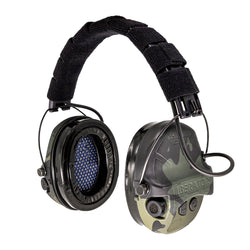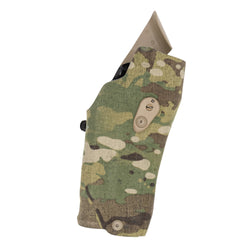Is there a reason for a 50-meter pistol drill? Most self-defense shootings take place at seven yards or less. They’re typically fast, stressful, and require minimal aiming.
When you’re fighting for your life at a close distance, your instinct is to point and shoot. At that distance, there isn’t much need for careful sight alignment, right?
Very few defensive engagements happen at 50 meters. Yet, there’s a reason for shooting your pistol at such a long distance. Part of this wisdom comes from Dan Brokos, the founder of Lead Faucet Tactical and a member of Safariland CADRE. In his popular YouTube video “Dan Brokos’ 50m Pistol Drill,” he says, “If you can dodge a wrench, you can dodge a ball.”

Translated into shooting terms, if you can consistently hit targets at 50 meters, then engaging targets up close becomes significantly easier. But there needs to be some pressure on how fast you are shooting. Standing and aiming at a target for three minutes to get the “bullseye” isn’t really the point.
As we all know, the further away you are from a target, the longer it will take you to make each shot. But that doesn’t mean you shouldn’t hold yourself to a time standard — even at 50 meters.
Let’s take a closer look at Dan Brokos’ 50 Meter Drill and see why it’s so helpful.
Why the 50 Meter Pistol Drill?
Dan Brokos’ 50-meter (or 54.6 yards) pistol drill is straightforward yet highly effective. It helps to sharpen your shooting skills at closer distances.
One of my favorite all-time movies is The Patriot starring Mel Gibson. In one of the scenes, he gives a musket to his son and tells him, “Aim small, miss small.” This phrase originated from Mark Baker, one of the firearms instructors on the movie set.

The idea is to aim for a specific area, smaller than your target. Even if you don’t hit the exact spot you’re aiming at, you’re still likely to hit the target—because your focus is tighter than the general target size.
With this drill, you sharpen your ability to hit a smaller target (while still being timed) at a longer distance. When you become proficient at this, shooting a larger target at a closer distance will become much easier, even at extreme speeds.
Shooting the 50-Meter Pistol Drill
The drill is simple. You’ll need an 8-inch target placed at 50 meters, or approximately 55 yards. I typically use 50 yards since that’s what my range has marked.
Start with your handgun holstered. On the beep, draw your handgun and start firing at the center of the target. Fire 10 rounds in 20 seconds. It’s best to use a shot-timer, but you can also have a friend time you if you do not have one.
This isn’t a fast-shooting drill, but keep in mind: at 50 meters (or yards), your dot or iron sights will look very large on top of what appears to be a small target.

Finding the right balance of speed and accuracy is important in this drill. Shoot too fast and you’ll miss. Shoot too slow and you’ll run out of time.
In his video, Brokos emphasizes the importance of trigger manipulation during this drill.
Practicing this drill regularly helps shooters develop superior control and confidence. Once you get comfortable with shooting at 50 meters, your accuracy at closer ranges naturally improves, significantly enhancing your real-world defensive capabilities.
I spend a lot of my time training between 7 and 20 yards when I’m using a handgun. So, of course, when I shot at 50 yards, it was definitely more challenging. After the first few times, I had holes all over my target. Some of this is because I was going too fast. A couple of times, I slowed down too much and ran out of time. Brokos wasn’t joking when he said this was a challenging drill.
How to Balance Speed and Accuracy
Speed and accuracy often seem like opposing forces. The faster you shoot, the less accurate you are; the slower you shoot, the more accurate you can be — right?
However, striking the right balance is the key to effective defensive shooting. One of my favorite drills for balancing speed and accuracy is the DOPE drill by Rick Crawley. He emphasizes shooting rapidly enough to neutralize threats while maintaining shots within the target’s effective area.
Instead of obsessing over tight groupings, focus on placing shots where they matter. On a person, that’s the chest—where the heart and lungs are.
To find the ideal balance, I like to start fast instead of slow. When you shoot, you will naturally look to see where you hit before making your next shot. This is called “hit confirmation” and it will slow you down.

Instead of trying to shoot perfectly and then get faster, push yourself faster than what you can do perfectly. The saying goes, “If you don’t shoot for the stars, you will never reach the sky.”
If you want to be fast and accurate, you must work on the fundamentals of accuracy, but then really push yourself. This is what the DOPE drill does. We have covered this drill before, but here’s a quick refresher on how it works.
Adding the DOPE Drill into Your Training
The DOPE (Data on Previous Engagements) drill is designed to help you find that balance of speed and accuracy. It is a point system drill that has you shooting at multiple distances while being timed.
To execute the DOPE drill, set up targets at 5, 10, 15, 20, and 25 yards. This is a drill you can do at indoor ranges from the low or high-ready position, depending on the rules of your range.
Starting at the five-yard line, fire five rounds as fast as you can at the center of the target. The key is understanding your firearm’s point-of-impact at each distance, thereby building valuable data or “DOPE.”

Once you mark your hits, move to the 10-yard line and repeat. Continue this process until you have performed the drill from every distance. Then calculate your “hit factor,” as explained in this article.
Practicing the DOPE drill alongside the 50-meter pistol drill creates an effective training program. Just remember, if you have an impressive grouping, you should be shooting faster!
If you can dodge a WRENCH, you can dodge a ball
Consistent practice at varying distances during timed drills teaches patience, breath control, a stable stance, and smooth trigger pulls. It also helps develop muscle memory for quick sight alignment and target acquisition. These skills transfer directly to rapid, instinctive shooting in self-defense encounters.
Think about it. If you’ve been shooting a target at 50 yards while being timed, a target at 7 yards will become much simpler.
Incorporate both the 50-meter pistol drill and the DOPE drill into your regular training schedule. You’ll quickly notice improvements in speed, accuracy, and confidence across all shooting distances. Remember what Dan Borkos said, “If you can dodge a wrench, you can dodge a ball.”









